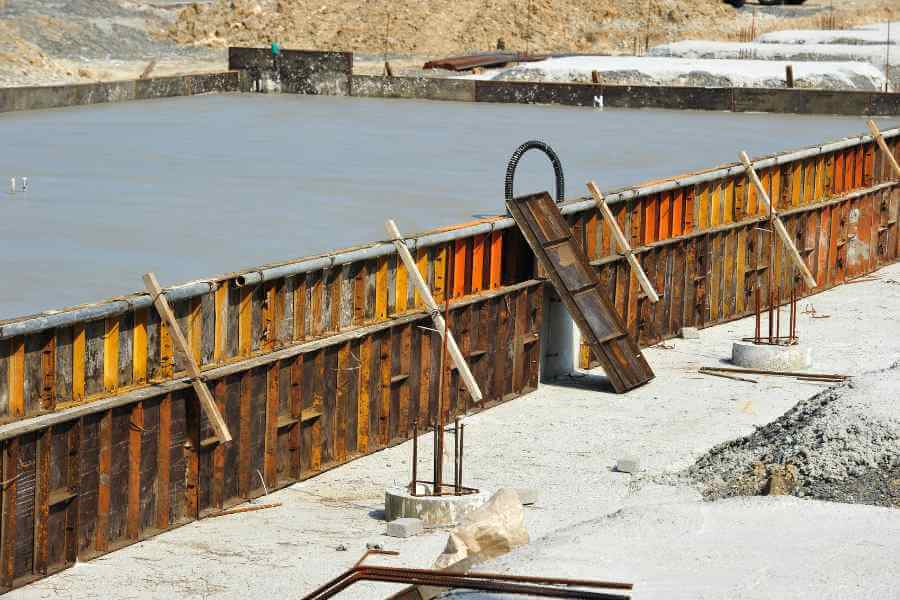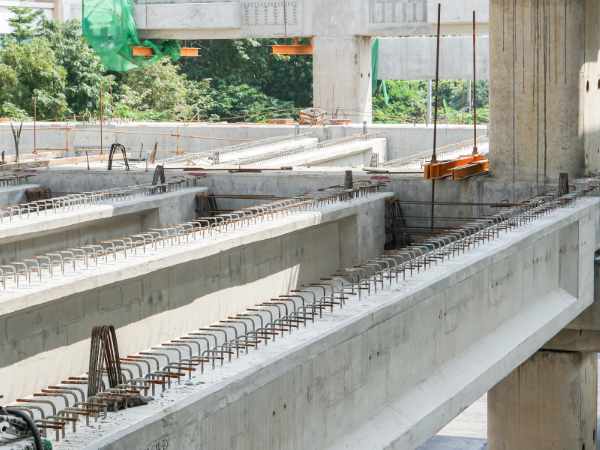The concrete mix hardening process begins after cement, aggregates and water are blended. The water hydrates the cement, eventually setting the mix and making it a hard mass. However, if certain conditions are not met (i.e. sufficient water is not available), concrete hardening might be drastically affected, leading to weakened and fragile structures.
Whilst concrete keeps hardening for its entire life, the construction industry has the 28-day mark as a reference point where the mixture reaches about 90-99% of its final strength and curing measures are extremely important. Concrete curing is a set of initiatives to provide and maintain optimal moisture, temperature, and time to allow the mix to achieve the desired properties.
When tight deadlines arise in a project, a common question is raised: Can you speed up concrete curing?
The answer is yes, curing can be accelerated using accelerators, high-performance mixes, and proper moisture management, allowing the concrete to gain strength more rapidly without compromising quality.
However, some special measures should be taken to ensure you do not have any issues affecting your structure – keep reading this article to understand more about rapid concrete curing, efficient methods and techniques, and powerful tips to help with your project.
What is Concrete Curing?
Concrete curing is a controlled process that involves maintaining suitable conditions, such as moisture presence and temperature, to enable optimal cement hydration reactions.
The cement particles react with water, forming a solid matrix that binds the aggregate together. This process is essential for achieving the desired strength and durability of concrete.
Curing should begin as soon as the concrete is placed and ideally continue for 28 days after initial placement. Among widely known curing measures are: ponding, the use of covers/blankets, and concrete curing membranes, such as waltools CAS 150.
How Long Does it Take to Concrete to Cure?
According to the Portland Cement Association, the time required for concrete to cure adequately varies based on several factors, such as mixture proportions, desired strength, size and shape of the structure, local environmental conditions (i.e. weather, humidity, air circulation), and future exposure conditions.
The table below summarises standard timeframes comparing concrete curing time and strength.
Time Frame | Strength |
7 days | Concrete expected to achieve circa 70% of final strength |
28 days | Concrete expected to achieve crica 90-99% of its final strength. |
It is noted that these timeframes might vary according to curing conditions. Overall, the ACI 308 recommends the following curing periods:
- ASTM C 150 Type I cement seven days
- ASTM C 150 Type II cement ten days
- ASTM C 150 Type III cement three days
- ASTM C 150 Type IV or V cement 14 days
- ASTM C 595, C 845, C 1157 cements variable

Can You Speed Up Concrete Curing?
Yes, it is possible to speed up concrete curing by implementing appropriate measures to ensure quality standards are kept, and the mix achieves designed strength. Several options are available to help accelerate concrete curing, such as:
- Use of curing accelerators (i.e. calcium chloride or non chloride chemical admixtures);
- Use of special covers to prevent moisture loss;
- Use of thermal curing;
- Use of special concrete mixes;
- Steam curing;
The table and paragraphs below further details some of them.
Option | Description | Mostly Used When |
Curing Accelerators | Chemical admixtures like calcium chloride or non-chloride accelerators promote faster hydration for quicker curing. | When early-age strength development is required. |
Covers to prevent moisture loss | Methods like covering with wet burlap, using curing blankets, or applying a curing compound help retain moisture. | In hot and dry weather conditions. |
Thermal Curing (Thermal Insulators) | In cold weather, insulation maintains the required temperature, speeding up curing. | During cold weather to maintain suitable temperatures. |
High-Performance Mixes | Concrete mixes with rapid hardening agents expedite curing without compromising long-term durability. | When rapid construction schedules are needed. |
Steam Curing | Controlled application of heat and steam accelerates the hydration reaction for faster curing. | For precast concrete elements or when time is critical. |
Recommended Article: Is Concrete Curing the same as Concrete Drying?
Curing Accelerators
Curing accelerators are chemical admixtures that expedite the hydration process in concrete. They work by providing additional reactive compounds that promote faster chemical reactions between cement particles and water.
The faster curing leads to early strength development, and this approach is commonly used when projects require rapid strength gain or when early-age strength development is essential, such as shotcrete in tunnels.
However, using these accelerators in a controlled manner is crucial, as excessive amounts can lead to potential issues such as reduced long-term strength, cracking, or increased risk of corrosion in reinforced concrete.
Commonly used products: Many accelerators are available in the market, such as waltools CAS 150 (below). Even though it is known as one of the cheapest options, the use of calcium chloride has decreased over time, given the increased risks associated with reinforcement corrosion (if you intend to use it, make sure you comply with the requirements of ACI 318)
Pros | Cons |
|
|
Concrete covers to prevent loss moisture
Using concrete covers to prevent moisture loss during curing is practical and cost-effective. In hot and dry weather conditions, the risk of rapid evaporation increases, which can lead to inadequate cement hydration.
Concrete curing covers, such as wet burlap or curing blankets, create a protective barrier over the concrete surface, reducing moisture evaporation and maintaining proper moisture levels.
Wet burlaps are a cheap alternative. When placed over the fresh concrete and kept damp, they create a moist environment that allows the concrete to cure gradually without losing essential moisture.
Similarly, curing blankets and tarps provide insulation, shielding the concrete from external factors and helping retain moisture within the curing environment.
You can read more about concrete curing covers in this article:
What is a Concrete Curing Blanket? (And When/Why to Use them?)
Thermal Insulators
Concrete thermal curing is a highly effective method for accelerating the curing process and enhancing early-age strength development. However, it will require more quality control efforts and specific equipment/devices, such as generators or electric heating systems.
Overall, the technique involves applying controlled heat to the concrete during the curing period, which helps to increase hydration rates allowing the concrete to gain strength more rapidly.
Concrete thermal curing is especially advantageous in cold weather conditions, where normal curing may be hindered due to reduced chemical activity. According to the Guide to Cold Weather Concreting (ACI 306R-16), cold weather conditions are defined as “...when the air temperature has fallen to, or is expected to fall below, 40°F (4.5°C) during the protection period.”
Concrete thermal blankets have emerged as a practical alternative to help concrete pouring and curing in low temperatures and are relatively easy to install and use.
You can read more about concrete curing covers in this article:
Special Concrete Mixes
Special concrete mixes can be developed to ensure faster curing and early strength characteristics. The following measures can be used in these special mixtures:
- Use of Fly Ash: Fly ash is a supplementary cementitious material that reacts with cement to enhance hydration. By incorporating fly ash into the mix, the concrete gains early strength more quickly.
- Slag: Slag, another supplementary cementitious material, contributes to the cement hydration reaction, accelerating early-age strength development.
- Use of Silica Fume: Silica fume, a fine pozzolanic material, improves the concrete’s strength and durability. Its incorporation in special mixes can promote faster curing and early-age strength.
- Controlled Particle Size Distribution: By carefully engineering the particle size distribution of cement and aggregates, the concrete’s reactivity and overall hydration process can be optimized for faster curing and early strength gain.
- Special Types of Cement: Special types of cement, such as high early-strength cement or rapid hardening cement, are formulated to provide faster strength development and are commonly used in these unique concrete mixes.
Steam Curing
Steam curing is a concrete curing technique that involves the controlled application of heat and moisture to accelerate the hydration process. It significantly speeds up the concrete’s early-age strength development, reducing the overall curing time.
This method is commonly used for precast concrete elements, ensuring faster construction schedules and early load-bearing capacity. However, proper temperature control and monitoring are essential to avoid potential issues such as surface cracking due to rapid drying.

FAQ
What is the best option to speed up concrete curing?
The best concrete curing method depends on the project’s conditions. For hot and dry weather, concrete covers are a cost-effective approach. In cold weather, thermal curing might be required.
What is the difference between concrete curing and drying?
Curing is the chemical process of maintaining adequate moisture and temperature to facilitate cement hydration. It starts immediately after concrete placement and continues for a specific period, usually lasting at least seven days but often extending to 28 days or more.
Drying refers to the evaporation of excess water from the surface of the concrete after it has reached its initial set. Unlike curing, which focuses on cement hydration, drying is necessary for the concrete to be ready for subsequent processes like finishing, surface treatments, and applying coatings.
Usually, concrete drying takes 48 hours to allow light traffic over it (walking). For heavy traffic (Cars, trucks), it is recommended to wait until it reaches 70% of its final strength (7 days). However, this can be sooner or later depending on project particulars.
How water affects concrete curing?
Water is essential for concrete curing. It enables cement hydration, leading to strength development.
The inadequate water volume will hinder hydration processes, leading to a weaker structure and, in some cases, excessive cracking. Excess water might also compromise its strength. Balance is crucial for successful curing.
What are the ideal conditions for concrete curing?
According to Portland Cement Association, you should maintain relative humidity in the concrete of greater than 80%, a temperature above 50 degrees Fahrenheit, and ideally keep these conditions for 14 days. However, optimal conditions might vary according to the mix used, intended use, etc.
Does heat help concrete cure?
Heat can accelerate concrete curing by promoting the chemical reactions involved in hydration. However, excessive heat can also cause rapid drying and potential cracking. Controlled and gradual temperature changes are essential for effective curing.
Does concrete cure faster in hot or cold weather?
Concrete cures faster in hot weather due to the increased rate of chemical reactions. However, extremely hot conditions can lead to rapid evaporation, which may lead to undesired outcomes, such as surface cracking.
In cold weather, curing takes longer due to reduced chemical activity, but proper insulation and temperature control can help accelerate the process, such as the use of concrete thermal blankets – read more about the in this article – Are Heated Concrete Blankets Effective?













